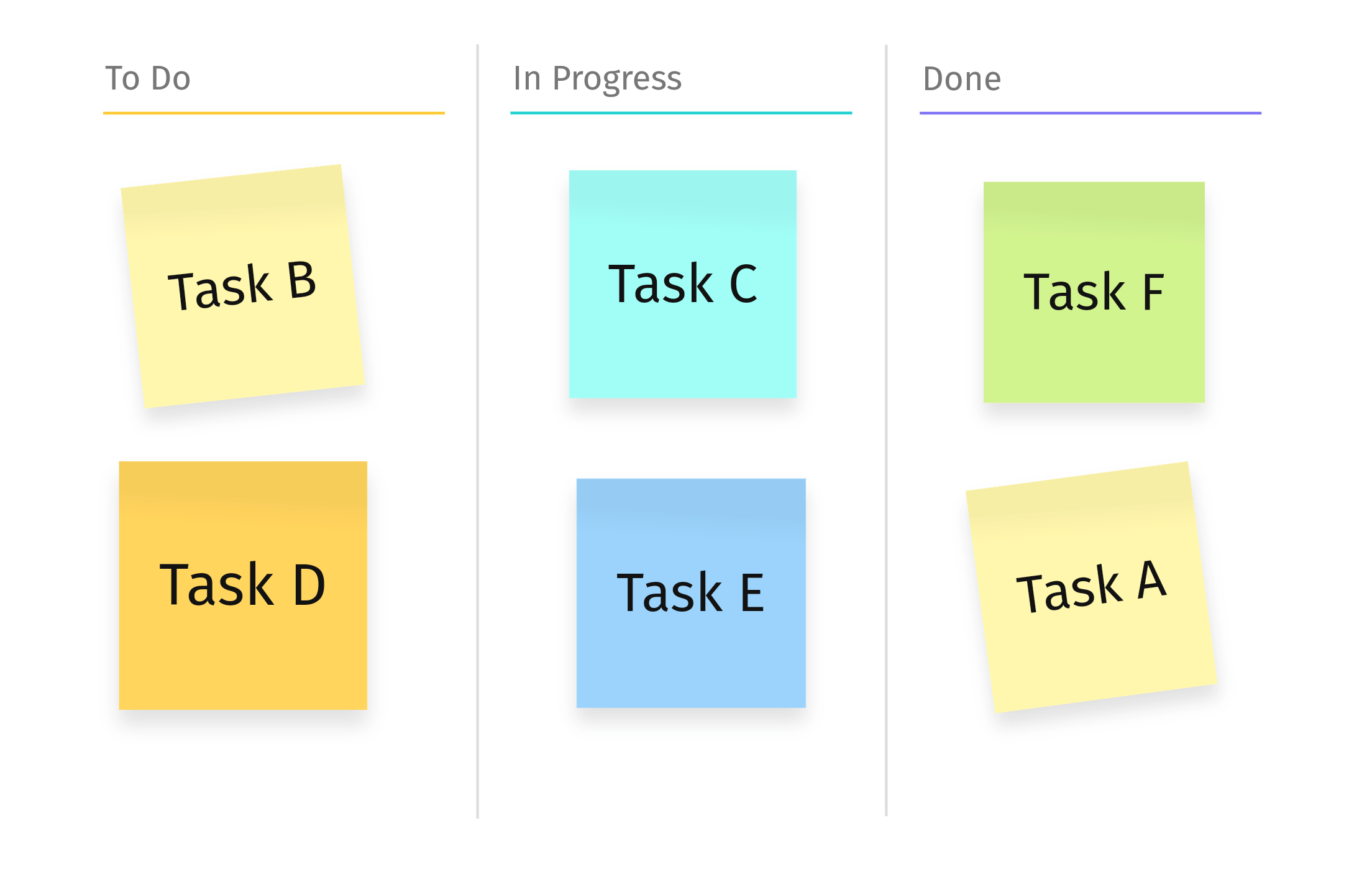Whether you work for a start-up or a long-standing business, no one is immune to misuse of time and resources. In fact, 60% or less of work time is spent productively. Even the world’s top automotive brand of 2020, Toyota, once struggled to use their resources to compete with American car manufacturers efficiently.
How do you rise above productivity struggles and manage projects like a boss? Well, for Toyota, the secret to their success started with an organized process that kept up with the needs of the industry — a system known as kanban.
What is kanban?
In the 1950s, Toyota director, Taiichi Ōno, harnessed the strategies used in American grocery stores to restock products, and created the kanban system to effectively produce their cars. This visual project management system utilizes a board and cards to track the flow of tasks in a process. This explains why the name “kanban” combines the Japanese words, “kan” 看 meaning sign, and “ban” 板 meaning a board. Focusing on where you’re at in the process rather than the end date, “The Toyota Way” by Liker describes the kanban system as, “Simple, effective, and highly visual.”
Toyota primarily uses the kanban system to improve efficiency and eliminate waste. Although “waste” takes on different forms from business to business, we all seek a way to prevent losing valuable time, money, and other resources. Businesses today are doing this with kanban boards.
3 simple elements of a kanban board
A kanban board is going to look different for each user depending on their needs. The board may be a collection of post-its on a wall, a template on an interactive whiteboard, or a virtual app like Asana or Trello. Regardless of the form it takes, each kanban board shares a few simple elements:

1. Board
A kanban board provides a bird’s eye view of a project’s workflow. Within this workflow live the various cards (tasks) that move right along each of the board’s lists (columns).
2. List/Lane
The columns of a kanban board, referred to as “lists,” feature a stage in a project. Traditionally, a board has a minimum of three lists positioned as follows from left to right: to do, in progress, and done. But depending on the project and industry, these columns are adaptable, just like the kanban process.
Some kanban boards also contain horizontal lists called swimlanes. Swimlanes are a helpful way to separate tasks by factors like priority, team, or service.
3. Card
Cards are the tasks that need to be accomplished. A card could simply contain the name of the task, a short description of what needs to be done, and the name of the person assigned to the task. But, thanks to the perks of digital boards, you can also attach relevant links and images to aid the user in the card’s completion. Cards get dragged to the right along each list to indicate their current stage in the process.
The perks of a virtual kanban system
Generally, a kanban board is a pretty basic system for managing projects that could result in millions of dollars in revenue. (Or billions in the case of successful kanban users Pixar, Spotify, and Zara, just to name a few.) Other than the potential for increased revenue, there are so many reasons to start using the kanban system. Here are some benefits to consider as you begin your kanban journey:
See the whole process in one view
Our brains process visual information 60,000 times faster than text, so it only makes sense that we use visual cues to get our work done. A kanban board provides the big picture of the whole process at one glance.
Eliminate the bottlenecks and increase accountability
When there are multiple steps and contributors involved in a process, it’s not uncommon for a holdup to occur. The transparent nature of a Kanban system allows you to easily see the task’s status and who is responsible for it at that stage. This transparency gives you power to nudge away the root of the bottleneck and keep the process flowing.
Keep your team in the know
Rather than hassling teammates for status updates, stay in-the-know by simply following a task’s progress on a kanban board. Apps like Trello even have the option to notify teammates when changes are made to a task, helping you maximize time and resources.
Prevent employees from being overloaded
Though it’s ultimately up to each company how to divvy up assignments, the kanban approach makes it easier to see who’s working on what, preventing individuals from being overburdened with too many tasks at once. Many kanban apps even let you set work-in-progress limits for how many tasks a team member can take on at a time.

Maximize the brain’s ability to focus
You may have several cards assigned to you, but that doesn’t mean you should do them all at once. A balancing act of tasks may seem efficient, but multitasking can reduce productivity by 40%. The kanban approach stresses the importance of working on one specific task at a time. This helps you tune out distractions and harness your brain’s focus power. Plus, that satisfaction from checking off one task gives you a boost to keep doing more.
Improve employee and customer satisfaction
Everyone is happier when deadlines are met and a service or product holds up to the standards promised by the brand. A streamlined workflow keeps everything in check to reach those goals, leaving you with a satisfied team and happy customers.
Let your ideas flow freely
There are certainly pros and cons to using a digital or physical kanban board. But a primary consideration is that a paper card or post-it can only hold so much information. With a digital kanban board, you can include pertinent links, hold discussions with your team, and write notes to your heart’s content.
Stay adaptable when priorities change
Change happens, and it can happen quickly. The needs of a client, the availability of technology, or maybe a pandemic could drastically change your original plans. A kanban board allows for easy re-prioritization at the click of a button.
How kanban is helping top industries succeed
You may not be in the car or grocery business, but you should always be in the business of efficiently completing goals. Here are some ways that professionals in various fields are using kanban boards to improve their productivity.
Education
COVID-19 changed our way of life — especially in the realm of education. Nearly 93% of households with school-age children reported some form of distance learning during 2020. A challenge for educators and students alike, remote learning requires proper tools and practices to bring order to the chaos. Kanban boards have delivered an effective system for keeping the whole class organized.
A shared kanban board for a class is mutually beneficial for the teacher and students. From the student perspective, they can keep up on deadlines, stay productive with checklists and individual tasks, and easily submit assignments all in one place. Plus, collaborating with other students on group projects or discussion boards is a breeze.
From the teacher perspective, you can clearly set assignment expectations with relevant links and notes, collaborate with students and share feedback, and get a birds-eye view of the students’ progress on assignments. Teachers can even use a kanban board for grading or lesson planning.
Engineering and construction
Engineering and construction involve so many moving parts (no pun intended). Keeping tabs on the status of a process can be difficult, especially when there are multiple teams involved. A kanban board helps teams prioritize and meet deadlines, while adapting to ever-changing industry standards.
Due to the evolving nature of engineering and construction tasks, a kanban board is the perfect project management route to help users see a task through to completion. Teams can also use kanban boards to gauge how long certain tasks take or where recurring issues appear to improve future processes.
Whether you need to efficiently transform parts into working machines, like Toyota, or coordinate the steps for a structure to transform from a blueprint to reality, a kanban process helps you manage your projects from start to finish. Take project planning to the next level by using Vibe to integrate engineering and construction apps and save valuable annotations.

Marketing
Good marketing teams produce a consistent flow of creative pieces. From blog and social posts to marketing campaigns and events, the initiatives are constant. The very best marketing teams create content that consistently meets the needs and expectations of a target audience, building some of the strongest brands out there. What sets a good marketing team apart from the best? Efficient planning and execution.
A kanban board is the best hack for keeping track of a myriad of pieces through each step as you schedule, write, edit, publish, and promote your work. Reduce the stress that accompanies those complex marketing campaigns and events by using your board to plan and carry out each step. For inspiration on how to better manage your processes, check out these examples of how to set up your kanban board for marketing projects.
Technology
A $1.9 trillion industry, the tech sector is the third largest sector in the U.S. economy behind only manufacturing and government. With so many new tech companies emerging, maintaining an organized system for keeping track of processes is essential. Where companies were once using the waterfall methodology to develop products, which involved sticking to fixed project specifications and delivering an end-product at the same time, innovative leaders now turn to kanban to match the demands of products with constantly changing features.
Many specialists have a hand in developing products for this adapting industry. Coordinating the tasks of coders, web developers, engineers, product designers, and many others would not be possible without a system that allows teams to view one another’s progress. By setting up a kanban board with swimlanes for each specialty within a tech business or IT department, the team members who specialize in a particular area can focus their attention on their own tasks but still have the ability to stay in-tune with others’ developments.
Professional services
The people in the business of serving others need a strategy for keeping up with the needs of clients. Consultants or those involved in leadership training can assign each of their clients to a kanban card. These cards can flow through the kanban board as professionals track their clients’ progress and goals.
For example, lawyers can use kanban boards to follow the flow of a client’s case. This is especially useful when a claim often encounters different people and is sometimes put on pause, involving a lot of waiting.
Regardless of the unique demands of your field, every business seeking to join the ranks of those with the most efficient project management processes need to jump on the kanban bandwagon. Create your own kanban board using one of Vibe’s user-friendly templates and integrated kanban apps to eliminate waste and enjoy the fruits of your smooth-running processes.
Vibe offers a collaborative solution combining an interactive digital whiteboard and innovative smart software. Increase engagement and efficiency at your brainstorming sessions, virtual training, and classroom sessions by integrating your favorite applications with video conferencing and an infinite, mess-free writing canvas. Collaborate today with Vibe.
Looking for the latest in interactive whiteboard technology? Check out Vibe today!
